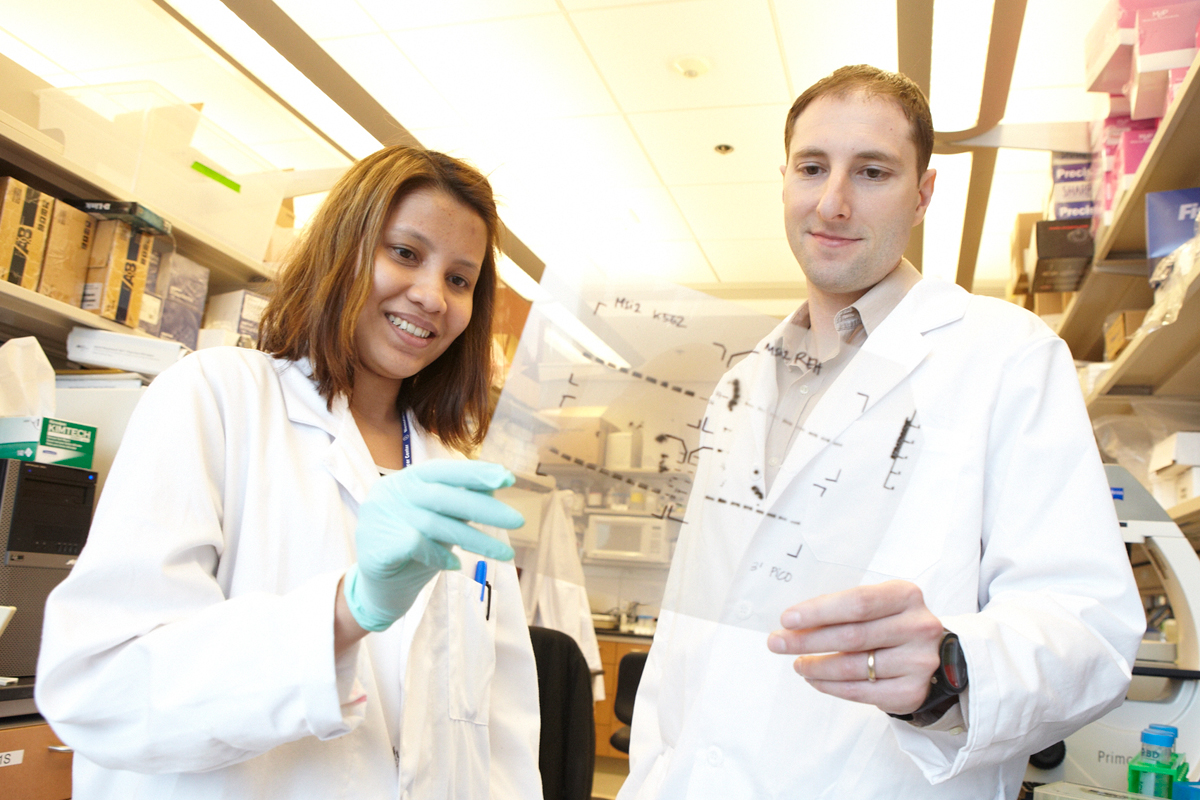Can studying zebrafish lead someday to new cancer treatments? How can poxviruses be used to cause tumor cell death? What do leukemia cells have in common with the stem cells from which normal blood cells develop? Three gifted young investigators are seeking answers to these and many other questions.
Meet them, learn about what they’re doing, and find out why they’ve made Memorial Sloan Kettering Cancer Center their research home.

Developmental biologist Mary Goll (right) and the members of her laboratory are using zebrafish as a model to study gene regulation.
When developmental biologist Mary Goll joined the Sloan Kettering Institute in the fall of 2010, she drove hundreds of zebrafish in coolers from Baltimore to her new laboratory in New York City. Dr. Goll uses zebrafish as an animal model to study proteins and processes that are important in the regulation of genes.
More specifically, her research is in the growing field of epigenetics. Epigenetics focuses on changes to the way genes are expressed — or translated into proteins and other cellular components — that are not related to changes in the actual sequence of their DNA. Epigenetic changes can lead to abnormal development and are almost always detected in the genomes of cancer cells.
Dr. Goll’s interest in the field began when she was an undergraduate at Cornell University, when a human genetics professor discussed the phenomenon of genomic imprinting. “We inherit two copies of every gene — one from our mother and one from our father — but one of these copies is silenced through a process called imprinting,” she says. “Silencing is caused in part by a small molecule known as a methyl group, which is added to the DNA. I was completely fascinated by the idea that methylation could enable two identical copies of DNA to behave differently — one silenced, and one activated.”
DNA methylation is one of the primary ways that epigenetic changes occur. It is essential for normal development in humans and other vertebrates, and researchers have found that patterns of methylation are disrupted in almost every cancer genome. Methylation patterns can also be passed on to other cells through cell division and potentially to subsequent generations.
When Dr. Goll launched her own laboratory, she knew she wanted to continue investigating the genes involved in methylation and clarifying their roles in animal development. She had the idea that a new, emerging research model — zebrafish — might provide opportunities to explore these areas.
“Zebrafish are useful for studying human development and genetics,” she explains. “Many genes are well conserved between fish and humans, and both species develop in a similar manner. In addition, zebrafish embryos are transparent, enabling scientists to view their early stages of development and perform live tissue imaging under a microscope.”
During the first few years she worked with zebrafish, as a Damon Runyon postdoctoral fellow at the Carnegie Institute for Science, in Baltimore, Dr. Goll and her colleagues developed a method for monitoring DNA methylation in live zebrafish larvae. They began by inserting a gene that codes for a green fluorescent protein (GFP). When expressed, this gene causes the zebrafish cells to have a green glow under a fluorescent microscope.
However, when the region of DNA that regulates the GFP gene becomes methylated, the gene is not expressed, preventing some or all of the cells from turning green. “The beauty of this scientific method is that by tracking a color change, we have a simple, live readout of methylation,” she says.
“When I was offered a position at the Sloan Kettering Institute, it seemed like a perfect fit,” she notes. “Understanding the fundamental biology of DNA methylation is highly relevant to cancer research. Now that I’m here, I appreciate having the opportunity to interact with a great community of scientists. I also have the resources and support to continue studying methylation in zebrafish.”
Dr. Goll’s laboratory is currently using zebrafish to investigate several different topics. They are trying to learn more about the purpose of methylation and determine which genes are required for that process. They also are studying different cells and different developmental stages to determine whether they have different requirements for methylation.
“When we find answers to these questions, we can better understand the diverse responses of tumors to methylation, which could lead to future cancer treatment targets,” she says. “I can’t imagine a more exciting or rewarding career path.”

Physician-scientist Liang Deng cares for patients with melanoma and other skin cancers and also conducts research on poxviruses.
When physician-scientist Liang Deng joined the Memorial Sloan Kettering faculty in 2004, it marked a homecoming, as she returned to the institution and the research specialty — poxviruses — that began shaping her career a decade earlier.
Now a physician on the Dermatology Service and head of a Memorial Hospital research laboratory, she pursues her twin passions of caring for patients with skin cancers and investigating poxviruses, which cause human and veterinary diseases but also offer great therapeutic potential.
“It’s very gratifying to help patients fight their skin cancers, while at the same time seeking better therapies,” Dr. Deng says. “And research into poxviruses offers the potential to harness the power of the immune system to fight deadly skin cancers such as melanoma.”
Dr. Deng grew up in China and studied biology at Fudan University, in Shanghai, before receiving her undergraduate degree from the University of Rochester, in New York. She then moved to Weill Cornell Graduate School of Medical Sciences to pursue a PhD degree. As part of that work, she studied poxviruses in the laboratory of Sloan Kettering Institute molecular biologist Stewart Shuman.
The most well-known poxvirus is vaccinia, which has been used in vaccines to eradicate smallpox. Under Dr. Shuman’s guidance, Dr. Deng used vaccinia as a model system to study transcription, the process by which genetic information is converted from DNA to RNA. Upon completing her graduate work, she transitioned immediately to medical training at Weill Cornell Medical College.
During medical school and dermatology residency (receiving some training in skin oncology at Memorial Sloan Kettering under the guidance of Dermatology Service Chief Allan C. Halpern, physician Patricia L. Myskowski, and others), Dr. Deng developed an interest in cutaneous immunity — the skin’s response to pathogens and allergens — and became curious about a subset of skin immune cells called epidermal dendritic cells and their role in infection and inflammation. After her medical training, Dr. Deng returned to Memorial Sloan-Kettering to combine patient care with research on the interface of dendritic cells and the poxviruses that first sparked her interest.
“Poxviruses are some of the most complex viruses known, and they are well suited to being modified for therapeutic use,” Dr. Deng explains. “It is easy to insert foreign genes coding for cancer antigens or immune-stimulating molecules into the viral genome. The poxvirus then can be used as a vector [a delivery system] to express these foreign proteins in immune cells, prompting an immune reaction against a specific target. In addition, poxviruses readily infect cancer cells, allowing them to be used to destroy these cells directly.”
Research from her laboratory, in collaboration with Dr. Shuman, cancer immunologist Alan Houghton, and immunologists Taha Merghoub and James Young, has identified several viral-sensing pathways by which immune cells detect poxviruses. Intriguingly, she and her colleagues also have discovered that poxviruses produce proteins that act as viral antagonists, allowing the virus to evade an immune attack from the host.
“We found that wild-type [natural] vaccinia actually suppresses the immune responses of infected dendritic cells,” she says. “By contrast, a weakened form of the virus called modified vaccinia virus Ankara [MVA] has a stimulating effect on dendritic cells.” MVA is now a leading vector in vaccines being tested against infectious agents and cancers.
In collaboration with cell biologist Xuejun Jiang’s laboratory, Dr. Deng’s team has also been investigating how poxviruses affect autophagy — a process in which a cell under stress breaks down its own components to recycle them for energy or to destroy the infectious agent. “It is fascinating that wild-type vaccinia inhibits autophagy, whereas MVA induces it,” she says.
In addition, Dr. Deng collaborates with medical oncologist Jedd D. Wolchok and his team to explore using poxviruses as oncolytic viruses. In this approach, the poxvirus is injected directly into tumors, causing cancer cell death. The destroyed cells release proteins called tumor antigens, which are presented by dendritic cells to other immune cells to induce immunity against cancer.
“I hope in the next five years, we’ll be able to incorporate oncolytic therapies into melanoma treatments,” she says. “But combination therapy will probably be necessary to enhance their efficacy.” She and Dr. Wolchok’s laboratory have preliminary results suggesting tumors can be destroyed more effectively by combining oncolytic therapies with a drug called ipilimumab, which removes a natural brake from the immune system and is already approved for use against advanced melanoma.
Growing up the son of two chemists, cancer biologist Michael Kharas knew from a young age that he wanted to “make drugs that doctors use to cure people.” Opportunities to work in research laboratories while he was still in high school gave him the first real sense of how exciting science could be.
While he was working as a postdoctoral fellow at Harvard Medical School, Dr. Kharas and his colleagues began studying the connection between cancer and stem cells, the cells from which various types of normal cells and tissues originate. “We found there are characteristics inherent in stem cells that tumors need in order to grow and progress,” says Dr. Kharas, an assistant member of the Molecular Pharmacology and Chemistry Program in the Sloan Kettering Institute. “The most aggressive cancer types appear to be mimicking certain traits of stem cells, such as the ability to regenerate.”

Cancer biologist Michael Kharas and research fellow Elianna Amin are studying proteins that determine the fate of stem cells.
To better understand this phenomenon, his group began investigating what leukemia cells have in common with hematopoietic stem cells, the cells from which normal blood cells develop. They identified a protein called Musashi-2, which both leukemia cells and hematopoietic stem cells produce in high amounts. Eventually, they discovered that Musashi-2 plays a role in some aggressive types of acute myelogenous leukemia (AML), the most common leukemia that affects adults.
At the cellular level, the protein functions by binding to RNA, a large biological molecule similar to DNA that catalyzes biological reactions, controls how genes are expressed, and helps send messages within cells. By binding to RNA, Musashi-2 regulates the expression of numerous genes.
Investigators believe the protein appears to be part of a genetic process that determines the fate of a hematopoietic stem cell — instructing it to either remain a stem cell or start differentiating so that it can eventually become a red blood cell, a white blood cell, or another type of blood cell.
“Our research has indicated that the same genetic process often is disrupted in AML,” Dr. Kharas explains, “contributing to the aggressive course the disease takes in some patients. It is tempting to speculate that future cancer therapies designed to manipulate the function of Musashi-2 could provide a new form of therapy that selectively targets leukemia cells with stem-cell-like characteristics.”
Currently, it is not well understood how the process that modulates a cell’s switch from “stemness” — its ability to become many different types of cells — to its differentiation into a particular cell type works at the molecular level.
Since joining the faculty of Memorial Sloan Kettering in 2011, Dr. Kharas has been exploring the mechanism by which Musashi-2 controls the fate of stem cells and tumor cells, and identifying other RNA-binding proteins that have a similar function. Clarifying this process may inform the development of new approaches to treat some cancers and blood disorders — for example, in the context of bone marrow transplantation.
“As in many other areas of biology, research on stem cells is largely a black box,” Dr. Kharas says. “I think we will be busy for a long time prying the box open. What eggs me on is the idea that we might one day be able to extract something useful — a sliver of understanding moving us one step closer to controlling cancer and other diseases.”

